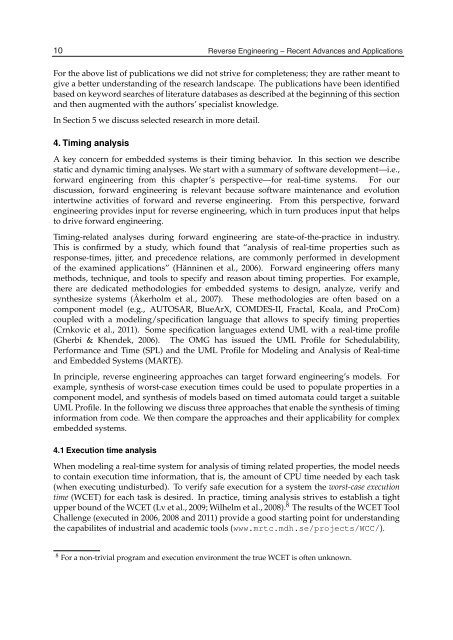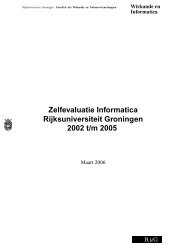Reverse Engineering – Recent Advances and Applications
Reverse Engineering – Recent Advances and Applications
Reverse Engineering – Recent Advances and Applications
You also want an ePaper? Increase the reach of your titles
YUMPU automatically turns print PDFs into web optimized ePapers that Google loves.
10 <strong>Reverse</strong> <strong>Engineering</strong> <strong>–</strong> <strong>Recent</strong> <strong>Advances</strong> <strong>and</strong> <strong>Applications</strong><br />
8 Will-be-set-by-IN-TECH<br />
For the above list of publications we did not strive for completeness; they are rather meant to<br />
give a better underst<strong>and</strong>ing of the research l<strong>and</strong>scape. The publications have been identified<br />
based on keyword searches of literature databases as described at the beginning of this section<br />
<strong>and</strong> then augmented with the authors’ specialist knowledge.<br />
In Section 5 we discuss selected research in more detail.<br />
4. Timing analysis<br />
A key concern for embedded systems is their timing behavior. In this section we describe<br />
static <strong>and</strong> dynamic timing analyses. We start with a summary of software development—i.e.,<br />
forward engineering from this chapter’s perspective—for real-time systems. For our<br />
discussion, forward engineering is relevant because software maintenance <strong>and</strong> evolution<br />
intertwine activities of forward <strong>and</strong> reverse engineering. From this perspective, forward<br />
engineering provides input for reverse engineering, which in turn produces input that helps<br />
to drive forward engineering.<br />
Timing-related analyses during forward engineering are state-of-the-practice in industry.<br />
This is confirmed by a study, which found that “analysis of real-time properties such as<br />
response-times, jitter, <strong>and</strong> precedence relations, are commonly performed in development<br />
of the examined applications” (Hänninen et al., 2006). Forward engineering offers many<br />
methods, technique, <strong>and</strong> tools to specify <strong>and</strong> reason about timing properties. For example,<br />
there are dedicated methodologies for embedded systems to design, analyze, verify <strong>and</strong><br />
synthesize systems (Åkerholm et al., 2007). These methodologies are often based on a<br />
component model (e.g., AUTOSAR, BlueArX, COMDES-II, Fractal, Koala, <strong>and</strong> ProCom)<br />
coupled with a modeling/specification language that allows to specify timing properties<br />
(Crnkovic et al., 2011). Some specification languages extend UML with a real-time profile<br />
(Gherbi & Khendek, 2006). The OMG has issued the UML Profile for Schedulability,<br />
Performance <strong>and</strong> Time (SPL) <strong>and</strong> the UML Profile for Modeling <strong>and</strong> Analysis of Real-time<br />
<strong>and</strong> Embedded Systems (MARTE).<br />
In principle, reverse engineering approaches can target forward engineering’s models. For<br />
example, synthesis of worst-case execution times could be used to populate properties in a<br />
component model, <strong>and</strong> synthesis of models based on timed automata could target a suitable<br />
UML Profile. In the following we discuss three approaches that enable the synthesis of timing<br />
information from code. We then compare the approaches <strong>and</strong> their applicability for complex<br />
embedded systems.<br />
4.1 Execution time analysis<br />
When modeling a real-time system for analysis of timing related properties, the model needs<br />
to contain execution time information, that is, the amount of CPU time needed by each task<br />
(when executing undisturbed). To verify safe execution for a system the worst-case execution<br />
time (WCET) for each task is desired. In practice, timing analysis strives to establish a tight<br />
upper bound of the WCET (Lv et al., 2009; Wilhelm et al., 2008). 8 The results of the WCET Tool<br />
Challenge (executed in 2006, 2008 <strong>and</strong> 2011) provide a good starting point for underst<strong>and</strong>ing<br />
the capabilites of industrial <strong>and</strong> academic tools (www.mrtc.mdh.se/projects/WCC/).<br />
8 For a non-trivial program <strong>and</strong> execution environment the true WCET is often unknown.




